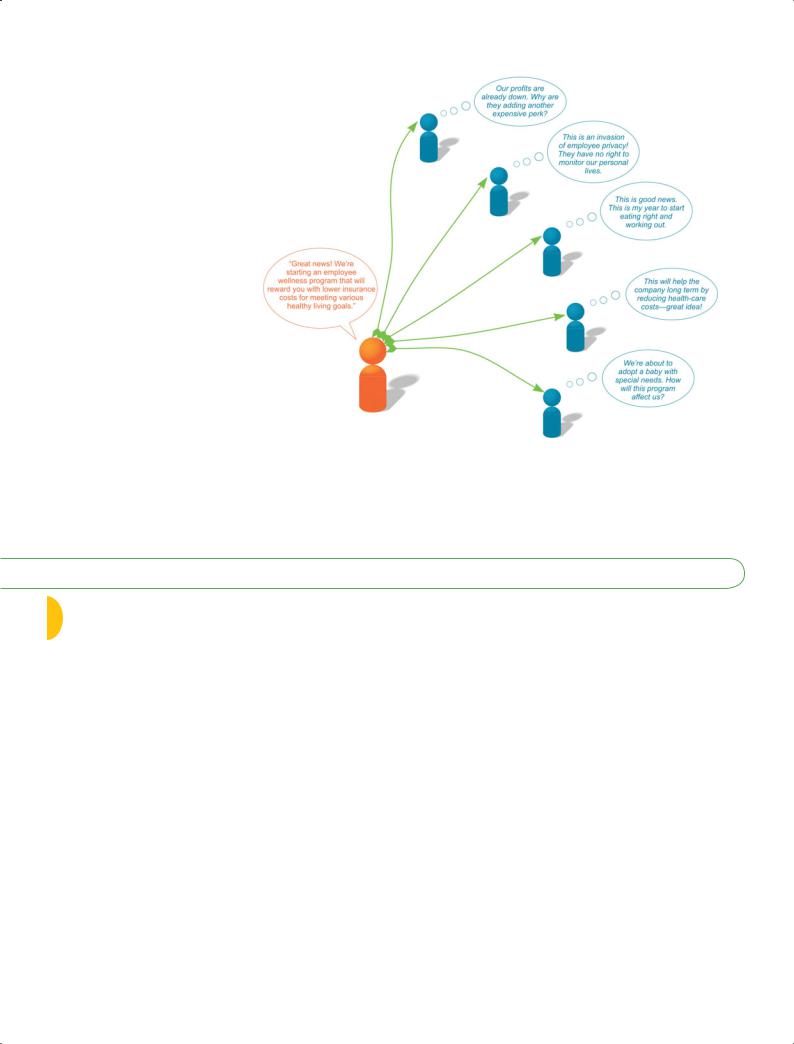
- •Understanding Why Communication Matters
- •Communicating as a Professional
- •Exploring the Communication Process
- •Committing to Ethical Communication
- •Communicating in a World of Diversity
- •Using Technology to Improve Business Communication
- •Chapter Review and Activities
- •Test Your Knowledge
- •Apply Your Knowledge
- •Practice Your Skills
- •Expand Your Skills
- •References
- •Understanding the Three-Step Writing Process
- •Analyzing the Situation
- •Gathering Information
- •Selecting the Right Medium
- •Organizing Your Message
- •Chapter Review and Activities
- •Test Your Knowledge
- •Apply Your Knowledge
- •Practice Your Skills
- •Expand Your Skills
- •References
- •Adapting to Your Audience: Building Strong Relationships
- •Adapting to Your Audience: Controlling Your Style and Tone
- •Composing Your Message: Choosing Powerful Words
- •Composing Your Message: Creating Effective Sentences
- •Composing Your Message: Crafting Coherent Paragraphs
- •Using Technology to Compose and Shape Your Messages
- •Chapter Review and Activities
- •Test Your Knowledge
- •Apply Your Knowledge
- •Practice Your Skills
- •Expand Your Skills
- •References
- •Revising Your Message: Evaluating the First Draft
- •Revising to Improve Readability
- •Editing for Clarity and Conciseness
- •Using Technology to Revise Your Message
- •Producing Your Message
- •Proofreading Your Message
- •Distributing Your Message
- •Chapter Review and Activities
- •Test Your Knowledge
- •Apply Your Knowledge
- •Practice Your Skills
- •Expand Your Skills
- •References
- •Electronic Media for Business Communication
- •Social Networks
- •Information and Media Sharing Sites
- •Instant Messaging and Text Messaging
- •Blogging
- •Podcasting
- •Chapter Review and Activities
- •Test Your Knowledge
- •Apply Your Knowledge
- •Practice Your Skills
- •Expand Your Skills
- •References
- •Strategy for Routine Requests
- •Common Examples of Routine Requests
- •Strategy for Routine Replies and Positive Messages
- •Common Examples of Routine Replies and Positive Messages
- •Chapter Review and Activities
- •Test Your Knowledge
- •Apply Your Knowledge
- •Practice Your Skills
- •Expand Your Skills
- •References
- •Using the Three-Step Writing Process for Negative Messages
- •Using the Direct Approach for Negative Messages
- •Using the Indirect Approach for Negative Messages
- •Sending Negative Messages on Routine Business Matters
- •Sending Negative Employment Messages
- •Sending Negative Organizational News
- •Responding to Negative Information in a Social Media Environment
- •Chapter Review and Activities
- •Test Your Knowledge
- •Apply Your Knowledge
- •Practice Your Skills
- •Expand Your Skills
- •References
- •Using the Three-Step Writing Process for Persuasive Messages
- •Developing Persuasive Business Messages
- •Common Examples of Persuasive Business Messages
- •Developing Marketing and Sales Messages
- •Chapter Review and Activities
- •Test Your Knowledge
- •Apply Your Knowledge
- •Practice Your Skills
- •Expand Your Skills
- •References
- •Applying the Three-Step Writing Process to Reports and Proposals
- •Supporting Your Messages with Reliable Information
- •Conducting Secondary Research
- •Conducting Primary Research
- •Planning Informational Reports
- •Planning Analytical Reports
- •Planning Proposals
- •Chapter Review and Activities
- •Test Your Knowledge
- •Apply Your Knowledge
- •Practice Your Skills
- •Expand Your Skills
- •References
- •Writing Reports and Proposals
- •Writing for Websites and Wikis
- •Illustrating Your Reports with Effective Visuals
- •Completing Reports and Proposals
- •Chapter Review and Activities
- •Test Your Knowledge
- •Apply Your Knowledge
- •Practice Your Skills
- •Expand Your Skills
- •References
- •Finding the Ideal Opportunity in Today’s Job Market
- •Planning Your Résumé
- •Writing Your Résumé
- •Completing Your Résumé
- •Chapter Review and Activities
- •Test Your Knowledge
- •Apply Your Knowledge
- •Practice Your Skills
- •Expand Your Skills
- •References
- •Submitting Your Résumé
- •Understanding the Interviewing Process
- •Preparing for a Job Interview
- •Interviewing for Success
- •Following Up After an Interview
- •Chapter Review and Activities
- •Test Your Knowledge
- •Apply Your Knowledge
- •Practice Your Skills
- •Expand Your Skills
- •References
- •Index

Chapter 3: Planning Business Messages |
57 |
Understanding the Three-Step Writing Process
No matter what kind of information you need to convey, your goal is to craft a message that is effective (it meets your audience’s needs and gets your points across) and efficient (it makes the best use of your time and your audience’s time). Following a clear and proven three-step process (see Figure 3.1) will help you meet both goals:
■Planning business messages. To plan any message, first analyze the situation by defining your purpose and developing a profile of your audience. When you’re sure about what you need to accomplish with your message, gather information that will meet your audience’s needs. Next, select the right medium (oral, written, visual, or electronic) to deliver your message. Then organize the information by defining your main idea, limiting your scope, selecting the direct or indirect approach, and outlining your content. Planning messages is the focus of this chapter.
■Writing business messages. After you’ve planned your message, adapt your approach to your audience with sensitivity, relationship skills, and style. Then you’re ready to compose your message by choosing strong words, creating effective sentences, and developing coherent paragraphs. Writing business messages is discussed in Chapter 4.
■Completing business messages. After writing your first draft, revise your message to make sure it is clear, concise, and correct. Next produce your message, giving it an attractive, professional appearance. Proofread the final product to ensure high quality and then distribute your message. Completing business messages is discussed in Chapter 5.
Throughout this book, you’ll see the three steps in this process applied to a wide variety of business messages: for short messages (Chapters 6 through 9), reports and proposals (Chapters 10 and 11), oral presentations (Chapter 12), and employment messages (Chapters 13 and 14).
The more you use the three-step process, the easier and faster writing will become for you. You’ll also get better at allotting your time for each step. As a general rule, set aside roughly 50 percent of your available time for planning, 25 percent for writing, and 25 percent for completing.
Using half your time for planning might seem excessive, but skipping or shortchanging the planning stage often creates extra work later in the process. First, taking the time to understand
1 LEARNING OBJECTIVE
Describe the three-step writing process, and explain why it will help you create better messages in less time.
The three-step writing process consists of planning, writing, and completing your messages.
As a starting point, allot roughly half your available time for planning, one quarter for writing, and one quarter for completing a message.
1 Plan |
2 |
Analyze the Situation
Define your purpose and develop an audience profile.
Gather Information
Determine audience needs and obtain the information necessary to satisfy those needs.
Select the Right Medium
Select the best medium for delivering your message.
Organize the Information
Define your main idea, limit your scope, select a direct or an indirect approach, and outline your content.
Write |
3 |
Adapt to Your Audience
Be sensitive to audience needs by using a “you” attitude, politeness, positive emphasis, and unbiased language. Build a strong relationship with your audience by establishing your credibility and projecting your company’s preferred image. Control your style with a conversational tone, plain English, and appropriate voice.
Compose the Message
Choose strong words that will help you create effective sentences and coherent paragraphs.
Complete
Revise the Message
Evaluate content and review readability, edit and rewrite for conciseness and clarity.
Produce the Message
Use effective design elements and suitable layout for a clean, professional appearance.
Proofread the Message
Review for errors in layout, spelling, and mechanics.
Distribute the Message
Deliver your message using the chosen medium; make sure all documents and all relevant files are distributed successfully.
Figure 3.1 The Three-Step Writing Process
This three-step process will help you create more effective messages in any medium. As you get more practice with the process, it will become easier and more automatic.

58 Unit 2: The Three-Step Writing Process
2 LEARNING OBJECTIVE
Explain what it means to analyze the situation when planning a message.
your audience members helps you find and assemble the information they need. Second, with careful planning, the writing stage is faster, easier, and a lot less stressful. Third, planning can save you from embarrassing blunders that could hurt your company or your career.
Of course, the ideal time allotment varies from project to project. Simpler and shorter messages require less planning than long reports, websites, and other complex projects. However, start with the 50-25-25 split as a guideline, and use your best judgment for each project.
Analyzing the Situation
Every communication effort takes place in a particular situation, meaning you have a specific message to send to a specific audience under a specific set of circumstances. Analyzing the situation gives you the insights necessary to meet your own needs as a communicator while also meeting the information needs of your recipients.
A successful message starts with a clear purpose that connects the sender’s needs with the audience’s needs. For example, describing your qualifications in an email message to an executive in your own company differs significantly from describing your qualifications in your LinkedIn profile. The email message is likely to be focused on one specific goal, such as explaining why you would be a good choice to head up a major project, and you can focus on the needs of a single, personally identifiable reader. In contrast, your social networking profile could have multiple goals, such as connecting with your peers in other companies and presenting your qualifications to potential employers, and it might be viewed by hundreds or thousands of readers, each with his or her own needs. These two scenarios have different purposes and different audiences, so they require distinctly different messages.
Business messages have both a general purpose and a specific purpose.
After defining your purpose, verify that the message will be worth the time and effort required to create, send, and receive it.
Defining Your Purpose
All business messages have a general purpose: to inform, to persuade, to collaborate, or to initiate a conversation. This purpose helps define the overall approach you’ll need to take, from gathering information to organizing your message. Within the scope of that general purpose, each message also has a specific purpose, which identifies what you hope to accomplish with your message. Define your specific purpose as precisely as possible, even identifying which audience members should respond, how they should respond, and when.
After you have defined your specific purpose, make sure it merits the time and effort required for you to prepare and send the message. Ask these four questions:
■Will anything change as a result of your message? Make sure you don’t contribute to information overload by sending messages that won’t change anything. Complaining about things you have no influence over is a good example of a message that probably shouldn’t be sent.
■Is your purpose realistic? Recognizing whether a goal is realistic is an important part of having good business sense. For example, if you request a raise while the company is struggling, you might send the message that you’re not tuned into the situation around you.
■Is the time right? People who are busy or distracted when they receive your message are less likely to pay attention to it.
■Is your purpose acceptable to your organization? Your company’s business objectives and policies, and even laws that apply to your industry, may dictate whether a given purpose is acceptable.
When you are satisfied that you have a clear and meaningful purpose and that now is a smart time to proceed, your next step is to understand the members of your audience and their needs.
Developing an Audience Profile
Before audience members will take the time to read or listen to your messages, they have to be interested in what you’re saying. They need to know the message is relevant to their needs—even if they don’t necessarily want to read or see your message. The more you know

Chapter 3: Planning Business Messages |
59 |
%YHMIRGI EREP]WMW RSXIW
Project: A report recommending that we close down the on-site exer cise facility and subsidize private memberships at local health clubs.
4VMQEV] EYHMIRGI Nicole Perazzo, vice president of operations, and her supervisory team.
7M^I ERH KISKVETLMG HMWXVMFYXMSR Nine managers total; Nicole and five of her staff are here on site; three other supervisors are based in Hong Kong.
'SQTSWMXMSR All have experience in operations management, but several are new to the company.
0IZIP SJ YRHIVWXERHMRK All will no doubt understand the financial considerations, but the newer managers may not understand the importance of the on-site exercise facility to many of our employees.
)\TIGXEXMSRW ERH TVIJIVIRGIW They’re expecting a firm recommendation, backed up with well-thought-out financial rationale and suggestions for communicating the bad news to employees. For a decision of this magnitude, a formal report is appropriate; e-mail distribution is expected.
4VSFEFPI VIEGXMSR From one-on-one discussions, I know that several of the managers receiving this report are active users of the on-site facility and won’t welcome the suggestion that we should shut it down. However , some nonexercisers generally think it’s a luxury the company can’t afford. Audience reactions will range from highly positive to highly negative; the report should focus on overcoming the highly negative reactions since they’re the ones I need to convince.
about your audience members, their needs, and their expectations, the more effectively you’ll be able to communicate with them. The planning sheet in Figure 3.2 provides an example of the kind of information you need to compile in an audience analysis. Conducting an audience analysis involves the following steps:
■Identify your primary audience. For some messages, certain audience members might be more important than others. Don’t ignore the needs of less influential members, but make sure you address the concerns of the key decision makers.
■Determine audience size and geographic distribution. A message aimed at 10,000 people spread around the globe will likely require a different approach than one aimed at a dozen people down the hall.
■Determine audience composition. Look for similarities and differences in culture, language, age, education, organizational rank and status, attitudes, experience, motivations, biases, beliefs, and any other factors that might affect the success of your message (see Figure 3.3 on the next page).
■Gauge audience members’ level of understanding. If audience members share your general background, they’ll probably understand your
material without difficulty. If not, your message may need an element of education.
■Understand audience expectations and preferences.
For example, will members of your audience expect complete details or just a summary of the main points? In general, for internal communication, the higher up the organization your message goes, the fewer details people want to see.
■Forecast probable audience reaction. As you’ll read later in this chapter, the way you organize a message should depend on the reaction you expect to get from
Figure 3.2 Using Audience Analysis to Plan a Message
For simple, routine messages, you usually don’t need to analyze your audience in depth. However, for complex messages or messages for indifferent or hostile audiences, take the time to study their information needs and potential reactions to your message.
Ask yourself some key questions about your audience:
■Who are they?
■How many people do you need to reach?
■How much do they already know about the subject?
■What is their probable reaction to your message?
If audience members have different levels of understanding of the topic, aim your message at the most influential decision makers.
A gradual approach and solid evidence are required to win over a skeptical audience.

60 Unit 2: The Three-Step Writing Process
Figure 3.3 Predicting the Effects of Audience Composition
As just one example of why it’s important to analyze the composition of your audience, the attitudes and beliefs of individual audience members can have a significant impact on the success of a message. In this scenario, for instance, a seemingly positive message about employee benefits can generate a wide range of responses from employees with different beliefs and concerns.
your audience. If you expect a favorable response, you can state conclusions and recommendations up front and offer minimal supporting evidence. If you expect skepticism or resistance, you can introduce conclusions gradually and with more proof.
3 LEARNING OBJECTIVE
Describe the techniques for gathering information for simple messages, and identify three attributes of quality information.
If a project doesn’t require formal research techniques, or you need answers in a hurry, you can use a variety of informal techniques to gather the information your audience needs.
Gathering Information
When you have a clear picture of your audience, your next step is to assemble the information you will include in your message. For simple messages, you may already have all the information at hand, but for more complex messages, you may need to do considerable research and analysis before you’re ready to begin writing. Chapter 10 explores formal techniques for finding, evaluating, and processing information, but you can often use a variety of informal techniques to gather insights and guide your research efforts:
■Consider the audience’s perspective. Put yourself in the audience’s position. What are these people thinking, feeling, or planning? What information do they need in order to move forward? If you are initiating a conversation in a social media context, what information will stimulate discussion in your target communities?
■Listen to the community. For almost any subject related to business these days, chances are there is a community of customers, product enthusiasts, or other people who engage in online discussions. Find them and listen to what they have to say.
■Read reports and other company documents. Annual reports, financial statements, news releases, blogs and microblogs by industry experts, marketing reports, and customer surveys are just a few of the many potential sources. Find out whether your company has a knowledge-management system, a centralized database that collects the experiences and insights of employees throughout the organization.
■Talk with supervisors, colleagues, or customers. Fellow workers and customers may have information you need, or they may have good insights into the needs of your target audience.
■Ask your audience for input. If you’re unsure what audience members need from your message, ask them if at all possible. Admitting you don’t know but want to meet their needs will impress an audience more than guessing and getting it wrong.
